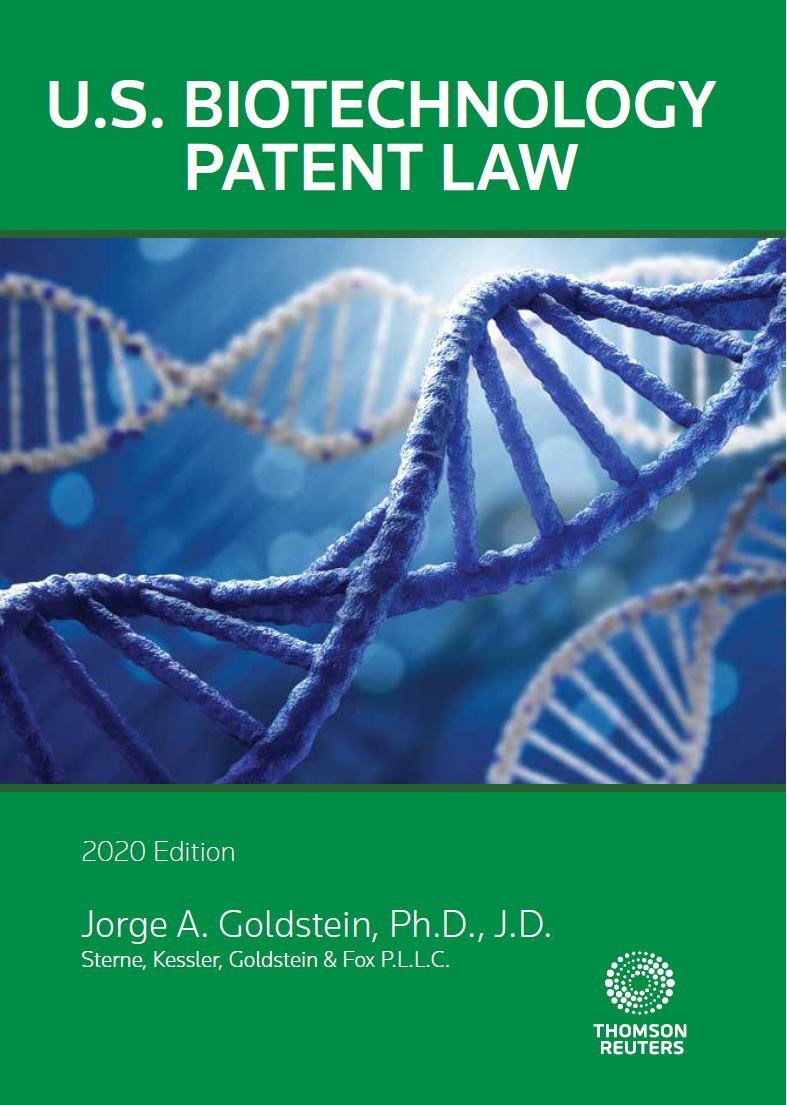U.S. Biotechnology Patent Law, 2020-2021 ed., authored by firm director Jorge A. Goldstein, Ph.D., is an update to the fourth edition.
U.S. Biotechnology Patent Law is a highly readable and well-organized desktop companion for practicing attorneys, and patent agents, seeking effortless entry into U.S. caselaw dealing with patents in modern biotechnology. Using the book’s descriptive subtitles or its double-entry tables, experienced or novice prosecutors, litigators, inside counsel or academicians can readily access any sub-area of the law, understand the legal background, and then find clear descriptions of the most important cases. The book’s focus is on biotechnology cases decided by the Court of Appeals for the Federal Circuit, its predecessor, the Court of Customs and Patent Appeals, the U.S. Supreme Court, and – when relevant – the U.S. Patent & Trademark Office Appeal Boards.
U.S. Biotechnology Patent Law features a contemporary format and feel, in both print and electronic formats. Each important biotech case is prominently highlighted and includes, in order:
- A summary and relevance of the holding;
- Separate patent claims (Since the holdings in patent law can only be understood in reference to the claims – Are they methods? Products? What are the exact words and limitations? – the author has separated the involved claims for immediate access.);
- Technology drawings or other facts needed for a clearer understanding; and
- Verbatim citations and quotes from the tribunal.
Throughout the publication, there are comments contained in shaded boxes, allowing the reader to easily distinguish the discussions in the cases from the opinions of the author. These comments include trends in the caselaw, critiques of outlier cases, and attempts to provide unifying themes to the historical and thematic development of the caselaw. Also included are diagrams that, at a glance, provide understanding of a body of caselaw, such as, for example, the development of a drug from early research to a time after approval by the FDA, or a summary of enablement and written description. The comments and diagrams are tabulated at the beginning of the book in a “Table of Comments.”
And, featured at the end of the book are a series of appendices in the form of double-entry tables that provide additional access to the caselaw. For example, if readers look for cases on antibodies across all statutes of the patent law, they find them in the appropriate row; if they want cases dealing with enablement across all scientific areas of biotechnology, they find them in the appropriate column; and if they want only enablement cases on antibodies, they find them in the cell at the intersection.
Highlights of This New Edition
Among the numerous revisions in this updated 2020-2021 edition are the following:
Chapter 3 Eligibility: Continued discussion of the guidance provided by the courts in the area. Updates include discussion of the following cases: Genetic Veterinary Sciences, Inc., v. Laboklin Gmbh & Co. KG, et al. (2019) and Illumina, Sequenom v Ariosa (2019). There were also notable nonprecedential cases: Ino Therapeutics LLC, Mallinckrodt Hospital Products Inc., v. Praxair Distribution Inc., Praxair Inc. (2019). The author has also added commentary on the emerging rules on the eligibility of biotechnology method claims.
Chapter 5 Enablement: Discussion of two additional cases where the courts used a Wands-type analysis to evaluate enablement outside the biotechnology context in Enzo Life Sciences, Inc. v. Roche Molecular Systems, Inc. (2019) and Idenix Pharmaceuticals LLC, et al v. Gilead Sciences Inc. (2019).
Chapter 6 Written Description: Discussion of Stephen Quake, et al v. Yuk-Ming Dennis Lo, et al (2019). In Stephen Quake, the court found replacement patent claims were not supported by the original written description and therefore not patentable under § 112.
Chapter 9 Novelty: Discussion of Amgen v. Hoechst Marion Roussel (2003) and In re Ditto (2012) and their impact on novelty applied to biotechnology claims.
Chapter 10 Obviousness: Discussion of Celgene Corp. v. Laura Peter, Deputy Director of the USPTO, Intervenor (2019). Celgene Corp. provides a good example of the relationship between claim construction and obviousness.

Receive insights from the most respected practitioners of IP law, straight to your inbox.
Subscribe for Updates
